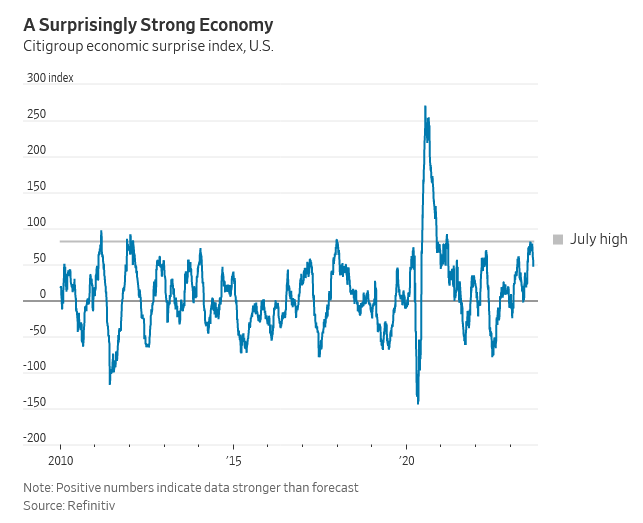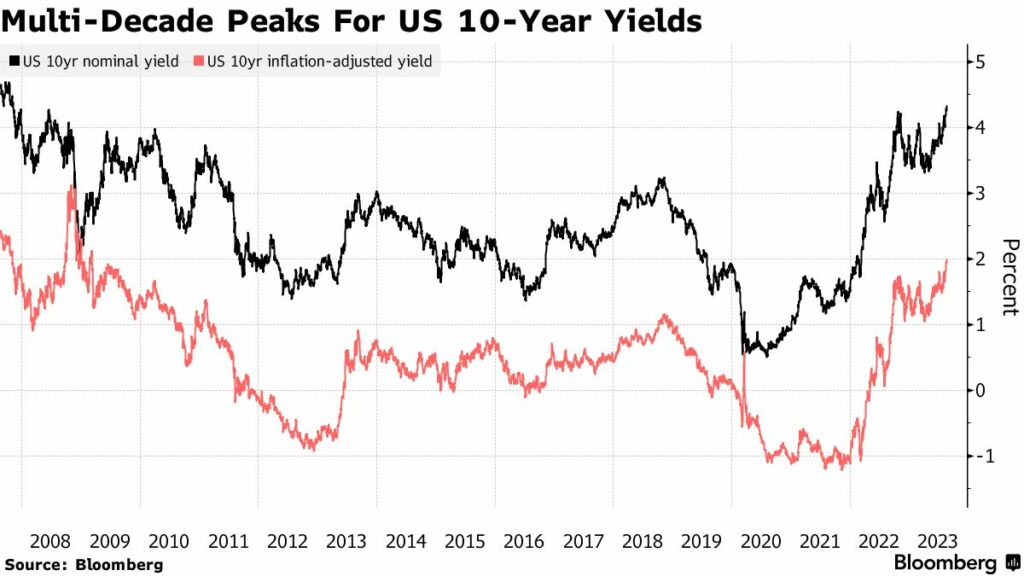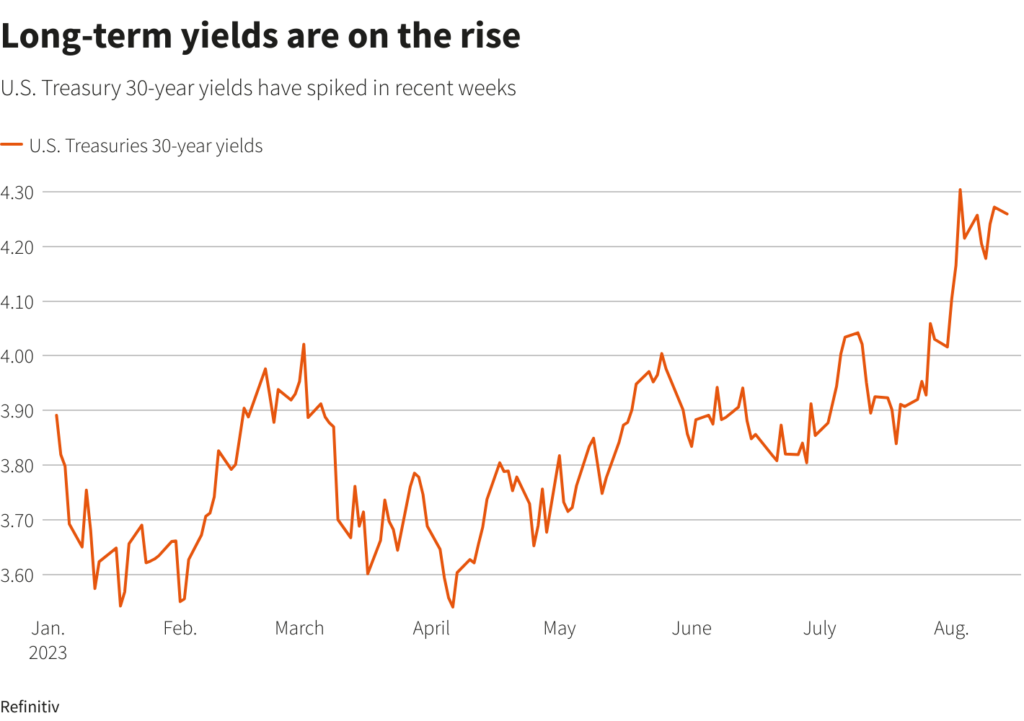Display results

14 September
Cooler Days
Quick Take: Bond yields soar (prices fall) as investors predict interest rates will stay higher for longer. Stocks took a breather following months of gains.
Amid a hot year for stocks, markets cooled in August, with major US equity indices closing lower. Following five consecutive months of gains, the S&P 500 and the tech-heavy Nasdaq lost 1.7% and 2.2%, respectively.[1] By the end of August, the S&P 500 was still up 17.4% year to date, with the Nasdaq up a rousing 34.1%.[2]

Source: https://www.wsj.com/finance/investing/the-generational-paradigm-shift-taking-over-markets-e1e7d4e6
Investors continue to spend confidently while believing in the potential for artificial intelligence to boost productivity, but stock markets fell for much of August before turning upward.[3] Treasury bond market gains for the year vanished as longer-term bond prices fell.[4] In this note, we’ll look at a few of the major drivers for last month’s markets.
Fitch Downgrade and Government Funding
August began with an abrupt credit rating downgrade from Fitch Ratings. Weeks after going to the brink of default during debt ceiling negotiations, Fitch Ratings downgraded the US government credit rating from AAA to AA+, citing increasing debt and political dysfunction in Washington.[5] For context, investors typically use credit ratings to evaluate the risk that borrowers such as governments and corporations could default on their debt. US government debt is generally considered the safest, nearly risk-free asset based on the belief in the U.S. government’s ability to pay its bills.
Lower-rated institutions often have to offer higher interest rates to borrow money from investors. However, because investors are unlikely to immediately lose faith in Treasuries as a safe haven, the practical impact of the Fitch downgrade appears minimal. Nonetheless, political stalemates pose ongoing challenges.
The latest political spat looms this fall as a government shutdown could occur as early as October 1 without Congressional approval on spending.[6] A shutdown could affect 4th quarter gross domestic product, which measures economic growth.[7] As with the debt ceiling negotiations, an agreement is still likely, but that doesn’t mean negotiations won’t go down to the wire and heighten market uncertainty.
Jackson Hole
Markets looked to the Jackson Hole Economic Symposium for clarity last month, as central bankers, economists, and financial experts gathered to discuss global economic issues and monetary policy.
The highly anticipated speech by Federal Reserve chair Jerome Powell revealed no major surprises, with Powell holding on to his “higher rates for longer” mantra.[8] Although he acknowledged that inflation has moved down from its peak, he left the door open for future rate hikes, stressing that policy decisions remain data-dependent and promising to “proceed carefully.”[9]
Atlanta Fed President Raphael Bostic says US monetary policy is “already restrictive enough” to reach a 2% inflation target, though that does not spell rate cuts any time soon.[10] Investors are currently betting that the Fed will not make any rate cuts until June 2024.[11]
Bond Yields Surge
Upbeat economic data has already bolstered investor belief that the Fed may sustain higher rates to tame inflation for longer, boosting yields on longer-term government bonds. When yields rise, bond prices fall. Rising rates can also divert demand away from risk assets.

Source: https://www.bloomberg.com/news/articles/2023-08-21/treasury-10-year-real-yield-tops-2-for-first-time-since-2009
Bond yields have been on an upward trajectory in recent months, most recently spurred by higher rates, the increasing size of Treasury bond issuance, and resilient economic data.[12] Investors often demand higher yield compensation as the supply of bonds increases. The surprising strength of the US economy has also played a role.
Despite whispers of an impending recession earlier this year, rising optimism of a soft-landing scenario has instead supported risk assets like equities and high-yield corporate bonds.[13] The latest survey by the National Association of Business Economics shows that almost seven in 10 economists polled are now at least somewhat confident that the Fed will achieve a soft landing.[14]

Source: https://www.reuters.com/markets/us/higher-for-longer-rates-regime-pressures-us-recession-trades-2023-08-16/
In August, benchmark 10-yr Treasury yields rose as high as 4.339%, the highest level since 2007.[15] 30-year Treasury yields similarly spiked on the back of longer-term concerns over US debt sustainability. As yields rose, mortgage rates climbed, topping 7% to levels not seen in 22 years.[16] The ripple effect also extended to increasing rates on auto loans and credit card rates.[17] After years of ultra-low borrowing costs, it may take some time for consumers to adjust to higher rates. Meanwhile, interest rates are finally rewarding savers with increased income.
Higher rates that slow growth and inflation may also lower the need for additional rate hikes, prompting many to believe that the Fed is done with rate hikes.[18]
What’s Next?
The next Fed meeting occurs in September, which is a month without corporate earnings to push stocks higher.[19] We also wouldn’t be surprised to see headlines saturated with political drama from ongoing budget talks.
A potential source of volatility comes from the Sept. 14 expiration of the United Auto Workers contract with the big 3 Detroit automakers. The U.A.W. president was elected last year on a platform to take a more combative and confrontational approach to talks than his predecessors. Labor unions across industries have been pushing for better working conditions and salary raises while displaying a willingness to walk out on the job. An auto strike could cost billions, and companies argue that concessions reduce corporate profitability and competitiveness.[20] However, organized labor, from port workers to UPS employees, have found success this year in renegotiating contracts with better benefits.[21] [22]
On the home front here in Los Angeles, we would be remiss to not mention the ongoing Hollywood writers’ strike – which officially began on May 2, 2023 and hit it’s 100-day mark back in August.[23] Despite SAG-AFTRA joining the WGA with a strike of its own on July 13, there has been seemingly little movement on either side of the picket line toward a resolution. [24] According to recent data from the U.S. Bureau of Labor Statistics, the entertainment industry alone has seen approximately 17,000 jobs lost due to the strike so far, combined with the ongoing SAG-AFTRA strike.[25] This strike has a ripple effect that spans far outside the entertainment community and touches a variety of industries in the local and state economy like dry cleaners, restaurants/food service, real estate and many more.[26] It is impossible to know the true economic impact of the strike as it is still unfolding, but we will continue keep a close eye on progress and hope a resolution will be reached soon.
Looming uncertainty may be unsettling, but as we highlight the unknown, the goal is not to raise concerns or trigger rash decisions. Basing investment decisions on daily or monthly news headlines is more likely than not to land you in hot water. As Vanguard founder John Bogle has said: “Time is your friend, impulse is your enemy.” [27]
We pride ourselves on a durable, strategic focus on wealth management that offers long-term predictability through inevitable ups and downs. Please feel free to reach out if you’d like to discuss the markets, your investment priorities, tax payments and financial needs. We are committed to supporting you and your personal objectives.
We hope everyone enjoyed the unofficial end of summer – and for those who embarked on 1st days of school recently, we wish you a great academic year ahead!
Your Friends at JSF
The information expressed herein are those of JSF Financial, LLC, it does not necessarily reflect the views of NewEdge Securities, Inc. Neither JSF Financial LLC nor NewEdge Securities, Inc. gives tax or legal advice. All opinions are subject to change without notice. Neither the information provided, nor any opinion expressed constitutes a solicitation or recommendation for the purchase, sale or holding of any security. Investing involves risk, including possible loss of principal. Indexes are unmanaged and cannot be invested in directly.
Historical data shown represents past performance and does not guarantee comparable future results. The information and statistical data contained herein were obtained from sources believed to be reliable but in no way are guaranteed by JSF Financial, LLC or NewEdge Securities, Inc. as to accuracy or completeness. The information provided is not intended to be a complete analysis of every material fact respecting any strategy. The examples presented do not take into consideration commissions, tax implications, or other transactions costs, which may significantly affect the economic consequences of a given strategy. Diversification does not ensure a profit or guarantee against loss. Carefully consider the investment objectives, risks, charges and expenses of the trades referenced in this material before investing.
Asset Allocation and Diversification do not guarantee a profit or protect against a loss.
The Bloomberg Barclays U.S. Aggregate Bond Index measures the investment-grade U.S. dollar-denominated, fixed-rate taxable bond market and includes Treasury securities, government-related and corporate securities, mortgage-backed securities, asset-backed securities and commercial mortgage-backed securities.
The S&P 500 Index is an unmanaged, market value-weighted index of 500 stocks generally representative of the broad stock market.
The Nasdaq Composite is a market-capitalization-weighted index consisting of all Nasdaq Stock Exchange listed stocks that are not derivatives, preferred shares, funds, exchange-traded funds or debenture securities.
Treasury Bond- is a U.S. government debt security with a fixed interest rate and maturity between two and 10 years.
Gross domestic product (GDP) is a monetary measure of the market value of all the final goods and services produced in a specific time period. GDP is the most commonly used measure of economic activity.
By clicking on these links, you will leave our server, as they are located on another server. We have not independently verified the information available through this link. The link is provided to you as a matter of interest. Please click on the links below to leave and proceed to the selected site.
[1] https://www.investopedia.com/dow-jones-today-08312023-7964094
[2] How major US stock indexes fared Thursday, 8/31/2023 | AP News
[3] Stock Market’s August Losses Snap Monthslong Winning Streak – WSJ
[4] Treasury Market 2023 Gains Vanish as Long-Dated Yields Rise (yahoo.com)
[5] https://www.wsj.com/articles/fitch-downgrades-u-s-credit-rating-56c73b89
[6] White House asks Congress for short-term funding to avoid shutdown (cnbc.com)
[7] A Government Shutdown Could Be Months Away—Here’s How It Would Further Roil Markets After Fitch Downgrade (forbes.com)
[8] Analysis: Powell’s ‘higher for longer’ mantra fans investor caution over economy | Reuters
[9] Fed Chair Powell calls inflation ‘too high’ and warns that ‘we are prepared to raise rates further’ (nbcnews.com)
[10] Atlanta Fed’s Bostic Sees U.S. Policy as ‘Restrictive Enough’ (wsj.com)
[11] Treasury yields and dollar rise after Jay Powell warns on inflation | Financial Times
[12] US Ramps Up Debt Issuance, Adding Fuel to Selloff in Treasuries – Bloomberg (US Treasury ramps up debt issuance, announces it will sell $US103b of longer-term securities (afr.com))
[13] Higher-for-longer rates regime pressures US recession trades | Reuters
[14] US economy poses key question: Are we facing higher-for-longer interest rates? | AP News
[15] https://www.wsj.com/finance/stocks/rising-long-term-rates-loom-over-autumn-on-wall-street-3ee03b95
[16] https://www.wsj.com/economy/housing/mortgage-rates-hit-7-23-percent-72688ccd
[17] US economy poses key question: Are we facing higher-for-longer interest rates? | AP News
[18] US economy poses key question: Are we facing higher-for-longer interest rates? | AP News
[19] Stocks Have Had a Great Year. Cue the September Effect. – WSJ
[20] AEG analysis: UAW strike cost estimated at $5 billion in 10 days (cnbc.com)
[21] US West Coast port workers ratify contract agreement | Reuters
[22] UPS workers approve new contract with hard-fought gains, ending strike threat (nbcnews.com)
[23] https://www.forbes.com/sites/antoniopequenoiv/2023/08/09/hollywood-writers-strike-heres-a-timeline-of-what-led-to-the-100-day-mark/?sh=5524d47c7ad3
[24] https://www.forbes.com/sites/antoniopequenoiv/2023/08/09/hollywood-writers-strike-heres-a-timeline-of-what-led-to-the-100-day-mark/?sh=5524d47c7ad3
[25] https://www.hollywoodreporter.com/business/business-news/writers-strike-update-union-studios-break-off-amptp-1235585993/
[26] https://finance.yahoo.com/news/hollywood-writers-strike-creates-ripple-effects-across-californias-economy-other-states-204742894.html?guccounter=1&guce_referrer=aHR0cHM6Ly93d3cuZ29vZ2xlLmNvbS8&guce_referrer_sig=AQAAANxnOTMpucgupEN6rwCUPHOtp1Umk-1BzDm5ZGPK7U08Cvlv-pFqCluYvvPN7ErSv6R1eyaRBIdF-Qas-Llb08WM9l-ovZ64teql3QqZpQmyZozUaFjUq-2GtL-cXvbDeYSezZIp-cuNf26G1pmuC6Xn-akkgc4QajZ2EdRZLV4U
[27] https://www.cbsnews.com/news/john-bogles-10-rules-of-investing/
Read more